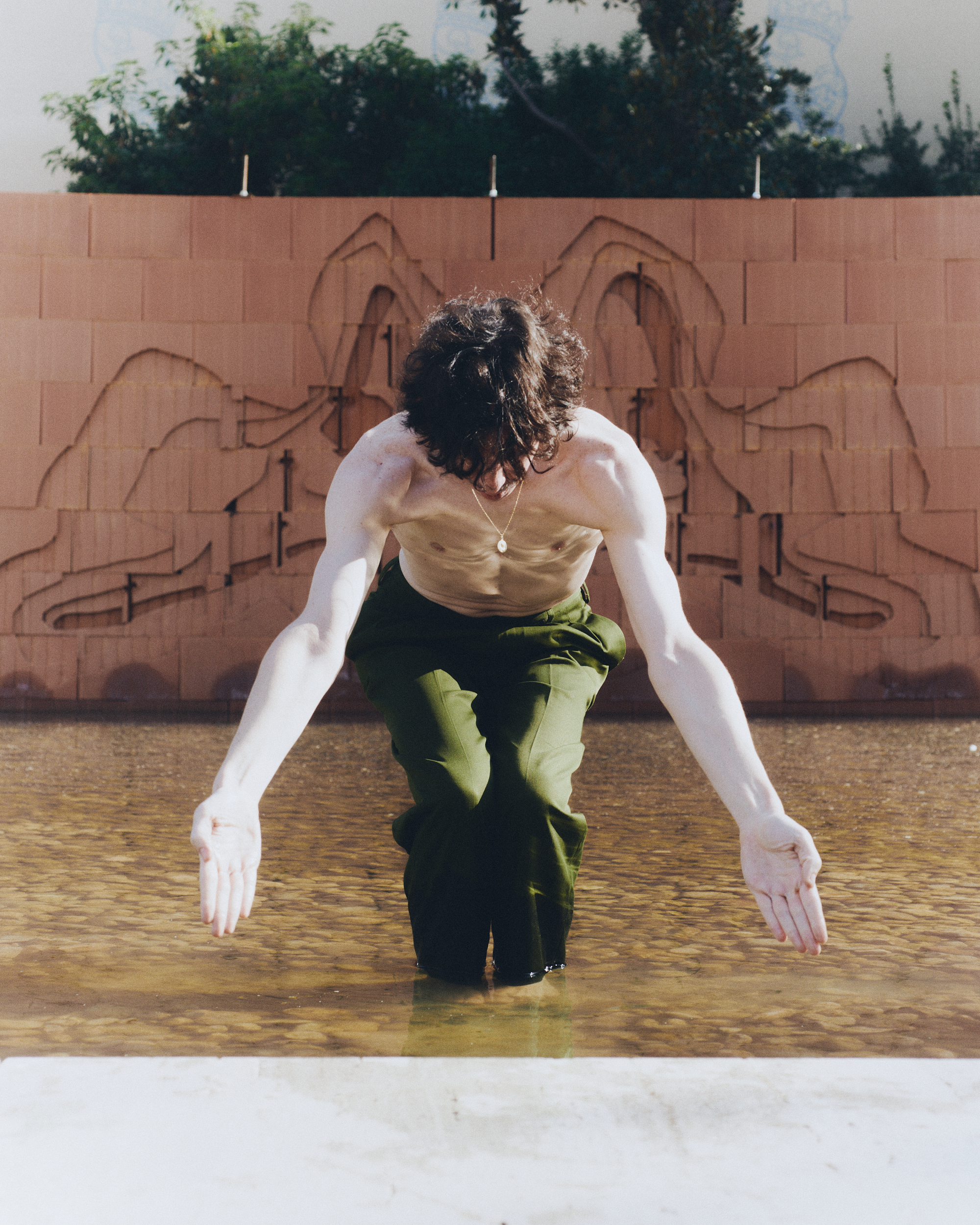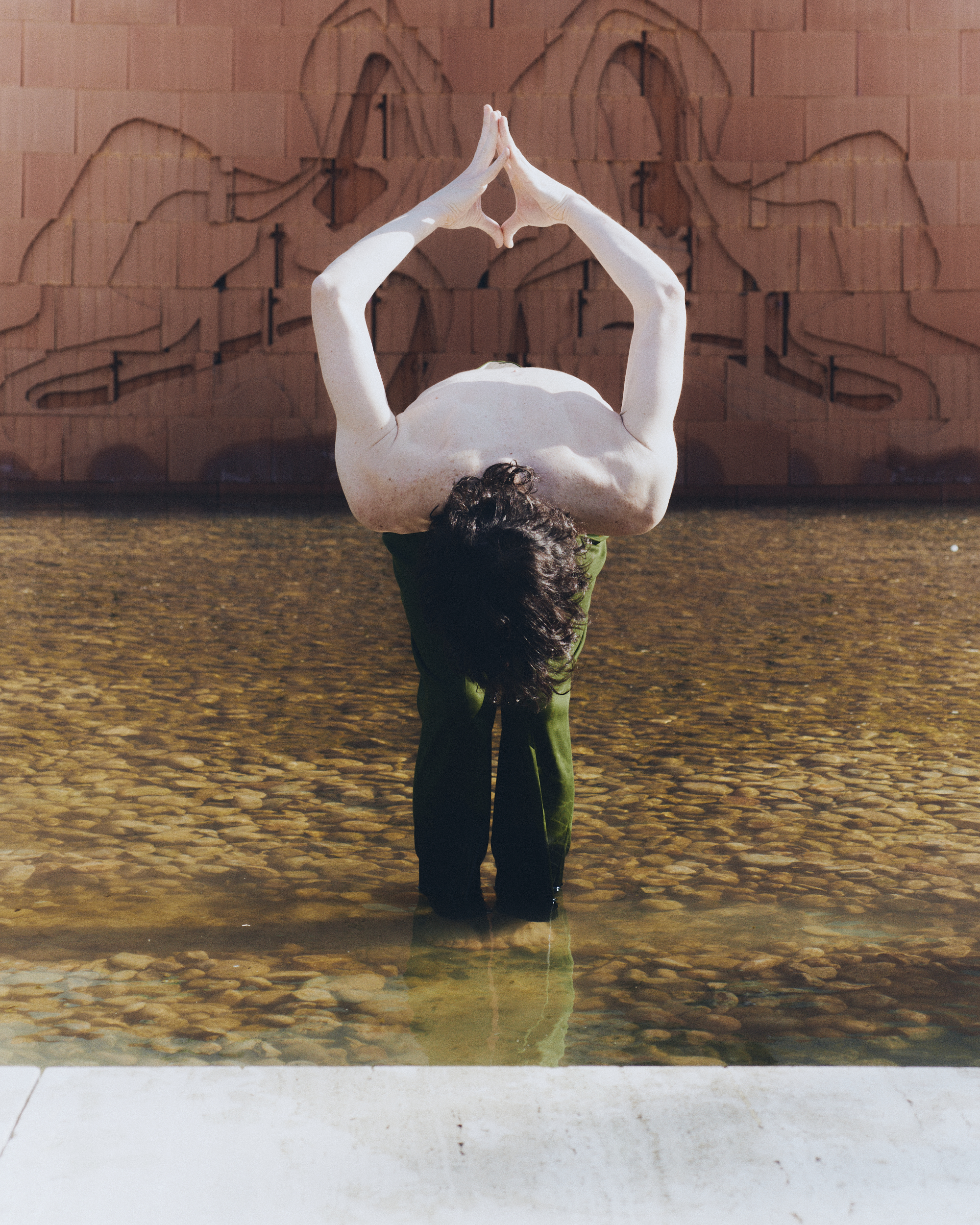| Este proyecto es fruto de la colaboración entre la Fundación Mies van der Rohe y El Graner, centro de creación de danza y artes vivas
(Texto para el programa) 41°22′14″N 2°09′00″E son las coordenadas del Pabellón Mies van der Rohe de Barcelona y dan título a la intervención artística que realizaré sobre otra intervención: Psicoarquitectura, la obra de Oscar Abraham Pavón que, a su vez, interviene el propio pabellón. Esta cadena de capas —mi acción sobre la obra de Pavón, su obra sobre la arquitectura de Mies, y la arquitectura de Mies sobre el terreno que ocupa— configura una constelación de gestos superpuestos. Un edificio que fue erigido en 1929, desmontado un año después y reconstruido en 1986 en su ubicación actual, convertido ya en su propia memoria reconstruida. La pieza de Pavón, centrada principalmente en un muro de ladrillo erguido sobre la lámina de agua del pabellón, cuyo reflejo duplica y distorsiona la forma, me invita a reconsiderar el poder innato del acto creativo y la manera en que la materialidad altera su sentido. Me interesa explorar el efecto y la resonancia que produce el cuerpo al entrar en fricción con materiales primordiales y arquetípicos como el agua, el ladrillo o el mármol. Quiero generar una deriva que atraviese el edificio y lo habite desde su dimensión transformadora y desde su memoria, confrontándolo con mi propia experiencia arquitectónica, que en este caso se condensa en la figura del muro. El templo, el museo, la biblioteca e incluso el muro son construcciones que, en distintos momentos de mi vida, me han representado. El muro, en particular, ha sido simultáneamente superficie artística y lugar de encuentro. A lo largo de los años he desarrollado con él una relación íntima, marcada por mi cercanía a la práctica del graffiti. He escrito sobre muros en incontables ocasiones —sobre todo mi nombre—, un nombre que ha cambiado con el tiempo, volviéndose abstracto, indecible, casi mudo. Para mí, el muro ha sido arrastre y resistencia. Un soporte cargado de potencia: muro de carga, muro de lamento, muro de deseo. Un muro que protesta, exhibe, oculta y resguarda. Muros que se levantan y que caen; muros de tránsito y muros frontera. El acto creativo, como la energía, no se crea ni se destruye: se transforma. Las ideas circulan, se alojan en nosotros y nos modifican; a veces habitan un edificio y a veces son los edificios quienes les dan forma. Lo arquitectónico puede ser origen, recipiente o catalizador, pero siempre es lugar de paso para lo que todavía está por imaginar. |
Creación e interpretación Manuel Rodriguez
Acompañamiento artístico: Javier Pividal
Sonido: Aire
Fotos: Pablo de Pastors
[ENG]
This project is the result of a collaboration between the Mies van der Rohe Foundation and El Graner, a center for the creation of dance and performing arts.
(Text for the program)
41°22′14″N 2°09′00″E are the coordinates of the Mies van der Rohe Pavilion in Barcelona, and they give title to the artistic intervention I will carry out over another intervention: Psicoarquitectura, the work by Oscar Abraham Pavón, which itself intervenes upon the pavilion. This creates a constellation of superimposed gestures—my action over Pavón’s piece, his work over Mies’ architecture, and Mies’ building over the ground it now occupies. A structure erected in 1929, dismantled a year later, and reconstructed in 1986, the pavilion has become a reenactment of its own memory.
Pavón’s piece, centered around a brick wall rising above the pavilion’s reflecting pool—its form doubled, distorted, and unsettled by the water—invites me to reconsider the innate power of the creative act and the ways materiality inflects and transforms it. I am interested in exploring the effect and resonance generated when the body collides with primordial, archetypal elements such as water, brick, or marble. My intention is to traverse the building and inhabit it from its transformative nature and its memory, confronting it with my own architectural experience, which in this case crystallizes in the figure of the wall.
Temples, museums, libraries—and even walls—are architectural forms that have represented me at different stages of my life. The wall, in particular, has been both artistic support and site of encounter. Over the years, through my proximity to graffiti practice, I have developed a singular relationship with it. I have written on walls countless times—most often my name, a name that has changed over time, becoming abstract, unsayable, nearly mute.
For me, the wall has been both pull and resistance. A structure charged with potency: a load-bearing wall, a wall of lament, a wall of desire. A wall that protests, exhibits, hides, and protects. Walls that rise and fall; walls of passage and walls as border.
The creative act, like energy, is neither created nor destroyed: it only transforms. Ideas circulate; they inhabit us and reshape us. Sometimes they originate within a building, and sometimes it is through a building that they take form. Architecture can be source, container, or catalyst—but always a place of passage for what has yet to be imagined.






